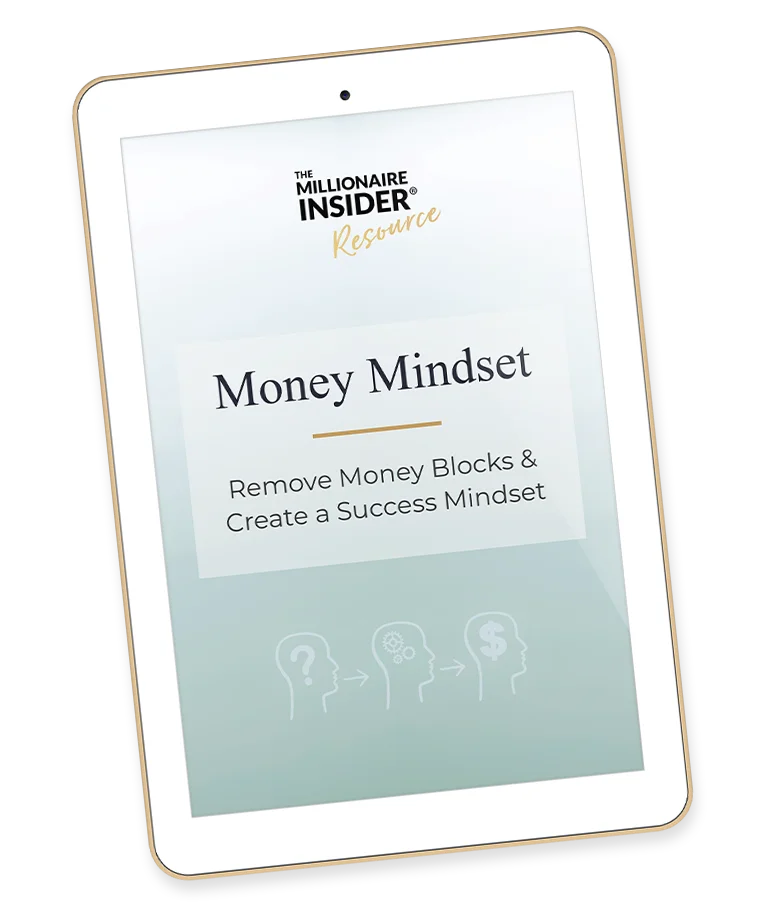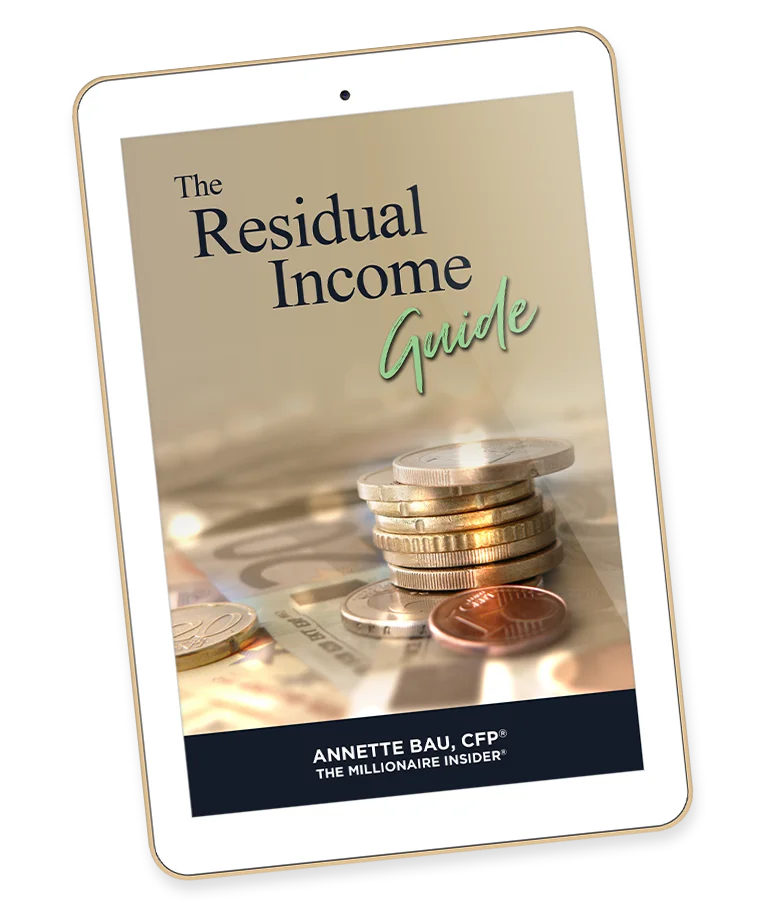 Today, you will learn how to create a financial plan that works for you and your situation.
Today, you will learn how to create a financial plan that works for you and your situation.
Most financial advisors (myself included) are trained to help our clients create a plan. We are not trained to help people in the psychology of wealth.
Examples include overspending, impulse buying, panicking when the market drops, emotional spending, fear of numbers, beliefs such as wealthy people are dishonest, money is the root of all evil, or “I could never afford that” or “I want to enjoy life now and not worry about the future.”
When you overspend, most advisors tell you not to spend so much. And when a client says she is terrible with numbers, we reassure her that is untrue. And when a person has money blocks, we call a colleague and ask, “What is a money block?” Or refer them to a psychologist.
The ideal plan includes the inner and outer game of money and a traditional and non traditional plan.
Creating a Traditional Financial Plan
You and your family are the only people who feel the long-term effects of creating or not creating a financial plan. That is why starting early and sticking to your game plan is essential.
Most people create a traditional financial plan. With the numerous options available, more people are including a non-traditional component in their plan.
A traditional path entails planning, saving, investing, accumulating wealth, and creating passive income streams to support your lifestyle.
A traditional financial plan includes your cash flow, expenses, and insurance.
Examples of insurance include:
- Property and casualty
- Disability insurance
- Umbrella policy
- Life insurance
- Long-term care coverage
Depending on your situation, you may need additional insurance coverage.
It also includes your tax, retirement, and estate plan.
The non-traditional financial plan includes:
- The psychology of wealth.
- Removing and releasing money blocks.
- Alternative cash flow methods and income streams.

The best strategy for you and your family depends on your situation.
Individuals with an abundance mindset and are meeting their retirement goals generally use the traditional model.
However, if you have money blocks and are struggling to achieve your financial goals, you may want to consider non-traditional options.
A solid financial plan will allow you to:
- Remove money blocks
- Save money
- Budget for future expenditures now and in retirement
- Invest for your long-term goals, like retirement
- Pay for your kids’ or grandkids’ college tuition
- Achieve other objectives based on your situation
In my experience, creating a financial plan that combines traditional and non-traditional elements is ideal. This will help ensure you create a secure retirement and financial future.
Create a Financial Planning To-do List

Let’s begin by creating a to-do list of what you need to do to achieve your financial goals. This list is essential to your financial security, so create your list based on your situation and priorities.
Examples include:
- Identify and remove money blocks that are keeping you stuck.
- Create a monthly budget that includes your yearly expenses and income.
- Fund an emergency reserve fund with three to twelve months of expenses.
- Create a retirement plan that will support you after you retire.
- Invest in and monitor a diversified investment portfolio.
- Identify and create multiple streams of income.
- Save for other financial objectives.
- Determine and purchase the insurance coverage you need (P&C, health, disability, long-term care, life, umbrella, etc.).
Start Early
The best time to create a financial plan was ten years ago. The next best time is today.
Instead of beating yourself up for not beginning earlier in life, commit to starting today.
Whether you team up with your partner or go it alone, the path to financial independence is not always a smooth, perfectly paved road. But don’t despair; it’s time to roll your sleeves up and get your hands dirty. That’s right—it’s time to learn how to create a solid financial plan.
How to Create a Financial Plan for Yourself and Your Family
1. Set Your Financial Goals
The first step is to identify the financial and retirement goals you want to achieve.
Once you know your goals, consider creating affirmation statements.
The best format includes “I am” or “I (active verb)” statements. I (or my partner and I) earn $100,000 (in the year) with ease, or I accumulate (amount) net worth with ease. Write out clear, well-defined goals that you prioritize.
And while I strongly encourage you to set big, hairy, audacious goals, make sure to set smaller milestones. That way, you can measure your progress and celebrate small wins on your journey.
2. Fund an Emergency Reserve
It is essential to fund an emergency fund for unforeseen circumstances.
This helps to ensure you do not have to use credit cards or borrow from your retirement to pay for unexpected expenses.
It is generally recommended that you fund your emergency reserve first. Then, you can start paying off your debt.
An emergency fund consists of six to 12 months of expenses. The amount depends on your situation. Consult with a financial advisor if you do not know how much to set aside.
3. Pay Off Debt
When you commit to a financial plan, it is essential to include a plan to get out of debt. It is difficult, if not impossible, to create a financially free life you love if you have significant debt.
First, list all your debt, including the interest rates you are paying. Then, prioritize which credit cards you will pay off first.
While it requires discipline, living debt-free is one of the best decisions you can make.
4. Purchase the Insurance You Need

The purpose of insurance is to protect you from a loss.
You work hard to earn your money; insurance provides a safety net if needed.
-
Health Coverage
Medical insurance covers the risk of an illness or injury. Larger deductibles reduce your monthly payments but increase the amount you may need to pay if you have a claim.
-
Property and Casualty Insurance
P&C insurance includes your auto, homeowners, rental, and personal liability policies. Reviewing your limits and deductibles with a qualified agent is critical.
-
Umbrella Policy
Depending on your assets, an umbrella policy may be applicable. An umbrella policy protects your assets if you are sued for more than your property and casualty insurance limits cover.
-
Disability Insurance
A disability insurance policy covers the loss of income if you can’t work. Because a loss of income can be devastating, consult a qualified disability specialist. An option for business owners is overhead insurance, which covers your monthly business expenses if you are disabled.
-
Long-Term Care Insurance
Another important insurance is for long-term care. Long-term care is expensive, as is the cost of insurance to protect against it. Your analysis must weigh the cost against the need and determine the coverage you require.
 Long-term care insurance policies are complex, so use a qualified expert.
Long-term care insurance policies are complex, so use a qualified expert. -
Life Insurance
Insurance on your life covers the loss of income from your death. Life insurance will provide your loved ones with the money they need.
Another reason to purchase life insurance is to cover the loss from the untimely death of a business owner or partner.
It is important to purchase enough insurance to cover the loss of money from an untimely death.
If you cannot afford to cover the loss of expenses your loved ones will need after your death, determine how you can lower your overall expenses or generate more income.
Examples may include downsizing your home, reducing your monthly expenses, or getting a part-time job or side hustle so you can afford the insurance premium.
-
Business Liability Coverage
If you are sued, both errors and omissions and business liability insurance may protect your business from liability.
You want to purchase coverage for items that have an expensive replacement value. This will help to ensure that you (and your loved ones) are protected financially if a loss occurs.
The right insurance plan can lessen the financial burden of a major disaster.
5. Create an Investment Plan

An investment plan allows you to put your money to work for you. The first step is to determine your goals, time horizon, risk tolerance, and other circumstances unique to your situation.
Investing is a long-term endeavor that requires patience, discipline, and commitment.
Money invested in the stock market or real estate is considered a long-term investment (seven to ten years). It is important to factor inflation into your investment plan.
If you need help, hire a professional to help you manage your investments.
6. Create a Retirement Plan
An ideal investment plan includes both after-tax and retirement (pre-tax) investments.  The first step is determining how much money you will need to retire in your desired lifestyle. It is essential to fund your retirement plan; this generally is an excellent strategy. Often, your employer will match a portion of your investment, which gives you free money.
The first step is determining how much money you will need to retire in your desired lifestyle. It is essential to fund your retirement plan; this generally is an excellent strategy. Often, your employer will match a portion of your investment, which gives you free money.
The best time to start saving for retirement is yesterday; the second best time is today!
7. Plan for Taxes
When determining your retirement plan, make sure your projections include taxes. Tax planning is vital because taxes can dramatically impact your monthly cash flow.
Hiring a qualified CPA or enrolled agent will help ensure your tax plan is adequate.
8. Create an Estate Plan
Estate planning is a critical element of a successful financial plan.
An estate plan provides instructions on what to do if you are incapacitated or die. It also identifies who will be responsible for managing and distributing your assets. If you have children, your estate documents will dictate who will serve as their guardian. Estate planning documents typically include a will or pour-over will, trust, financial power of attorney, and medical directive.
A qualified estate lawyer should set up and update your estate plan.
9. Schedule an Annual Financial Plan Review
Once you create a financial plan, the next step is to review it.
If your circumstances change, you need to update your plan. While an annual review is generally ideal, your situation will depend on the changes and events during the year.
Some people can go several years before an update is needed; others with a complicated financial situation should review it more frequently.
10. Master Your Money Mindset
While most experts leave this out, in my 30+ years of advising people, 
I can confidently share that a healthy money mindset is critical to long-term financial success. A successful money mindset identifies and removes beliefs and money blocks that keep you stuck. Understanding the psychology of money makes the path to financial freedom easier and more enjoyable.
Your journey to living a financially free life will likely have changes. There will be challenges as well as extraordinary, joy-filled moments. By focusing on your long-term goals and objectives, the setbacks and roadblocks will not deter you from your destination.
Tips on How to Create a Financial Plan
1. Calculate Your Net Worth Annually.
Your net worth is the sum of your assets (what you own) less your liabilities (what you owe). Even if you don’t have a lot of money, reviewing and monitoring your net worth is important.
From paying off debt to growing your net worth, all wins help keep you focused on your ultimate financial goal.
2. Monitor Your Spending Plan
Pay attention to where you spend your money and live below your means.
3. Stop Impulse Buying
If you have a history of impulse buying or difficulty living within your budget, go here and follow the 3-Day Rule.
4. Pay Bills By Due Date

Paying off your credit card each week helps you stick within your budget and not overspend.
5. Monitor Your Investment Statements
Always check your investment statements, especially when making deposits into your account.
Meet with your investment advisor at least annually.
6. Review Insurance Policies
Continue to review your insurance policies with your advisor annually. If your circumstances change, you must immediately review and update your insurance and overall financial plan.
7. Track Your Net Worth
It’s also essential to monitor your net worth over time to ensure you are on track with the long-term goals and financial objectives that you’ve set out to accomplish. Many people have a negative net worth when they start. But this often changes with time and their continued practice of good financial habits.
Why Do You Want to Achieve Financial Freedom?
Regardless of what is happening, wealthy people stay focused on their big-picture goals. They don’t sit around beating themselves up when they have a setback. Instead, they learn from it and move forward with new information that supports them in achieving their financial goals.
Most millionaires want to know how to create a financial plan. They also stay focused on the financial goals they want to achieve.
Conclusion – How to Create a Financial Plan
While learning how to create a financial plan is essential, implementing the plan is what will allow you to achieve your financial goals. That is the key. Remember, this is your life and your financial journey. The results will impact you and your family, which is why it is so important.
Planning for your future is the first step to living a financially free life you love!
Your Next Step Financial Step
If you want to know your financial house is in order, so you can have a secure financial future, click here:

